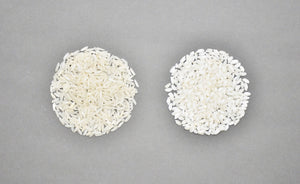A journey to the roots of rice
Rice is one of the oldest crops in human history, but did you know that there is more than just one type of rice? Since its origins, which date back about 10,000 years ago in the foothills of the Himalayas and the plains of Southeast Asia, rice has evolved into two large families: Japonica and Indica .
These two varieties have developed based on the climatic conditions and cultivation methods of the populations that first selected and cultivated it. But what makes them so different?
Japonica vs Indica: Two Faces of Rice
The two main varieties of rice are distinguished by specific characteristics that influence their texture, their use in cooking and the areas in which they are grown.
Japonica: the rice of temperate climates
-
Short, rounded grains, with a high starch content.
-
More sticky texture after cooking, ideal for risottos, sushi and creamy dishes .
-
It grows well in cooler and temperate climates, such as Italy, Japan, Spain and Korea.
-
It constitutes only 10% of the world's production , but it is appreciated for its quality and versatility.
Indica: rice from tropical regions
-
Long, thin grains, with a less sticky and lighter structure.
-
Perfect for dishes where the grains need to stay separate, such as rice salads, curries and Asian side dishes .
-
It prefers warm and humid climates, and is widespread in Asia, India, Thailand, Africa and South America.
-
It represents 90% of world production and is the most consumed variety.
The journey of rice around the world
After its first domestication, rice began its long journey across the world:
From Asia to Europe : The Arabs introduced rice cultivation to the Mediterranean, particularly in Spain and Italy.
From Europe to the Americas : With the arrival of European explorers, rice was also brought to the New World.
From India to Africa : Indica rice varieties have spread through trade routes, adapting to different ecosystems.
Rice: A Global Culture
Rice is not just a food, but a symbol of culture and tradition. From Italian risotto to Japanese sushi, from Indian basmati rice to Chinese fried rice, each population has adapted it to their own cuisine, making it a fundamental ingredient throughout the world.
Now that you know the two great families of rice, the next time you choose a rice for your recipe you will know exactly which variety is best! 😉

